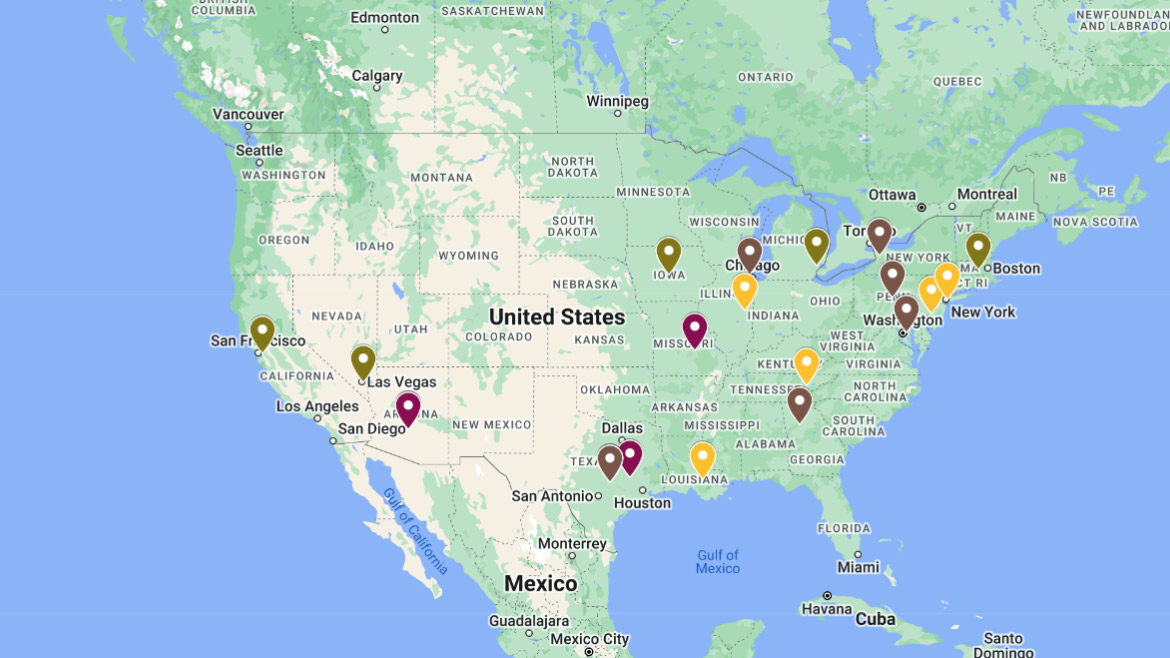As the clock ticks towards the Biden-Harris administration’s ambitious target of a net-zero emissions economy by 2050, the Department of Energy is placing its bets on a suite of industrial technologies to drive down greenhouse gases from one of the country’s hardest-to-abate sectors.
This month, DOE announced over $43 million in funding for 21 projects aimed at transforming how industry uses energy, tackling challenges from process heat to wastewater treatment. Read detailed descriptions of them all in the map below.
Jeff Marootian, DOE’s principal deputy assistant secretary for energy efficiency and renewable energy, framed the investments as a win-win for both the climate and America’s economic competitiveness.
“These investments will help the United States meet the Biden-Harris administration’s goal of a net-zero economy by 2050,” Marootian said. “Through the deployment of cost-competitive technology solutions, the U.S. industrial sector can increase global manufacturing competitiveness while reducing emissions in communities across the country.”
The projects fall into two buckets: a $38 million funding opportunity focused on cross-sector technologies and a partnership with the Electrified Processes for Industry without Carbon (EPIXC) Institute. DOE’s cross-sector approach recognizes that many decarbonization challenges cut across different industries, from chemicals to cement. By advancing technologies with broad applicability, the aim is to create solutions that can be tailored to various subsectors.
Electrification of Industrial Heat
- Ames National Laboratory (Iowa): Developing a solid-state elastocaloric heat pump for distillation applications, aiming for 40-80% carbon intensity reduction. ($2.6 million)
- Worcester Polytechnic Institute (Massachusetts): Working on laser-based process heating electrification for food and paper applications, targeting 20-40% energy efficiency gains. ($2.75 million)
- Blue Mountain Energy (Nevada): Building a high-lift air-source heat pump using advanced compression cycles and low-GWP refrigerants. ($3 million)
- Rondo Energy, Inc. (California): Creating an advanced heat battery for high-temperature industrial heating, aiming for 25-40% increased storage capacity. ($2.99 million)
- Lawrence Technological University (Michigan): Developing laser-based powder coat curing to replace inefficient natural gas ovens, focusing on lower temperature coating systems. ($1.2 million)
Efficient Energy Use in Industrial Systems
- Penn State University (Pennsylvania): Developing a ceramic silicon carbide heat exchanger for high-temperature heat recovery in direct-fired processes. ($2.49 million)
- University of Maryland (Maryland): Creating a cost-effective, highly efficient polymer-based heat exchanger for low- to medium-temperature waste heat recovery. ($1.47 million)
- Georgia Tech Research Corporation (Georgia): Scaling up continuous roll-to-roll fabrication of robust and tunable graphene oxide membranes for fractionation of complex feedstocks. ($2.13 million)
- GTI Energy (Illinois): Designing and demonstrating a high-temperature heat exchanger called the radiative exchanger with secondary emitters (RESE). ($2.28 million)
- The Research Foundation for SUNY on Behalf of the University at Buffalo (New York): Developing and scaling up new, solvent- and heat-resistant carbon-doped titanium oxide membranes for organic solvent separation. ($3 million)
- The University of Texas at Austin (Texas): Improving the selectivity performance of long-lifetime silver ion based facilitated transport membranes and achieving larger scale production. ($2.37 million)
Decarbonizing Organic Wastewater and Wet Organic Waste Treatment
- Philadelphia Water Department (Pennsylvania): Optimizing the performance of autothermal pyrolysis for converting wastewater biosolids into biochar and gas. ($2.5 million)
- Columbia University (New York): Developing and implementing control strategies to minimize N2O emissions from biological nitrogen removal and other processes. ($2.49 million)
- University of Illinois at Urbana-Champaign (Illinois): Focusing on minimizing N2O emissions from ammonia removal processes via ion-exchange and electrolysis. ($2.5 million)
- University of Tennessee, Knoxville (Tennessee): Using nanobubbles in various water resource recovery facility aeration processes to improve oxygen transfer and decrease energy requirements. ($2.5 million)
- Louisiana State University and Agricultural and Mechanical College (Louisiana): Combining a TiO2 catalyst with UVC LEDs to replace chlorine disinfection and reduce N2O emissions. ($2.24 million)
EPIXC Institute projects
- Arizona State University (Arizona): Evaluating the transition of three fossil-fuel based heating processes in the steel industry to electric-based heating, including ladle preheaters and billet reheating furnaces. ($471,659)
- Missouri University of Science & Technology (Missouri): Advancing an electrified testbed with a microwave plasma heating system to replace conventional natural gas burners in steel hot rolling operations. ($1.61 million)
- Arizona State University (Arizona): Evaluating electrification of the calcination process in cement manufacturing and potential cement replacement materials, using resistance-based electrical heating in a pilot-scale testbed. ($1 million)
- Texas A&M University (Texas): Focusing on the development and comparative analysis of two classes of electrified reactors (radio frequency and induction heating) for the catalytic dehydrogenation of propane. ($1 million)
- University of Texas at Austin (Texas): Investigating grid-synchronized distillation as a new operational strategy for industrial heating, providing electric heating for reboiler heat in distillation columns and synchronizing operation with carbon-free electricity availability. ($1.14 million)
Whether you require installation, repair, or maintenance, our technicians will assist you with top-quality service at any time of the day or night. Take comfort in knowing your indoor air quality is the best it can be with MOE heating & cooling services Ontario's solution for heating, air conditioning, and ventilation that’s cooler than the rest.
Contact us to schedule a visit. Our qualified team of technicians, are always ready to help you and guide you for heating and cooling issues. Weather you want to replace an old furnace or install a brand new air conditioner, we are here to help you. Our main office is at Kitchener but we can service most of Ontario's cities
Source link



